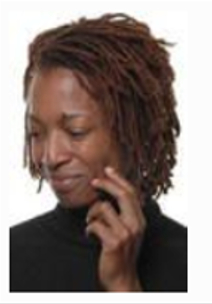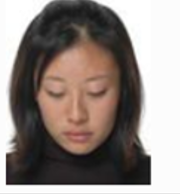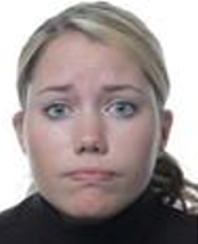Chapter 11: Negative Self-Conscious Emotions
Facial Expressions
In Keltner’s (1995) classic study, he utilized data from participants who had recently completed the Directed Facial Action (DFA) task in an earlier unrelated study. This task is described here . The data from participants who reported feeling embarrassment or amusement during the DFA was analyzed. Specifically, Keltner analyzed the facial expressions and bodily changes of participants in the 15-second rest period following each display of an emotional expression. Compared to participants who felt amused, embarrassed participants…
- looked down faster, spent a longer period of time looking down, and frequently changed their gaze location.
- showed more “smile controls” or attempts to conceal a smile or the zygomatic AU change.
- more lip presses (AU 24)
- turning head away from camera and more downward head movements
- more face touches
Figure 1 shows the facial changes that occurred overtime during the embarrassment experience. The duration of each facial change is from the left edge of the photograph to the end of the arrow. Thus, downward gaze is the facial change that last the longest, followed by head away. It is interesting to note that the embarrassment facial expression comprises several facial changes over a period of six seconds.
Figure 1
Facial Expression Change Over Time and Average Length of Each Change (Keltner, 1995)
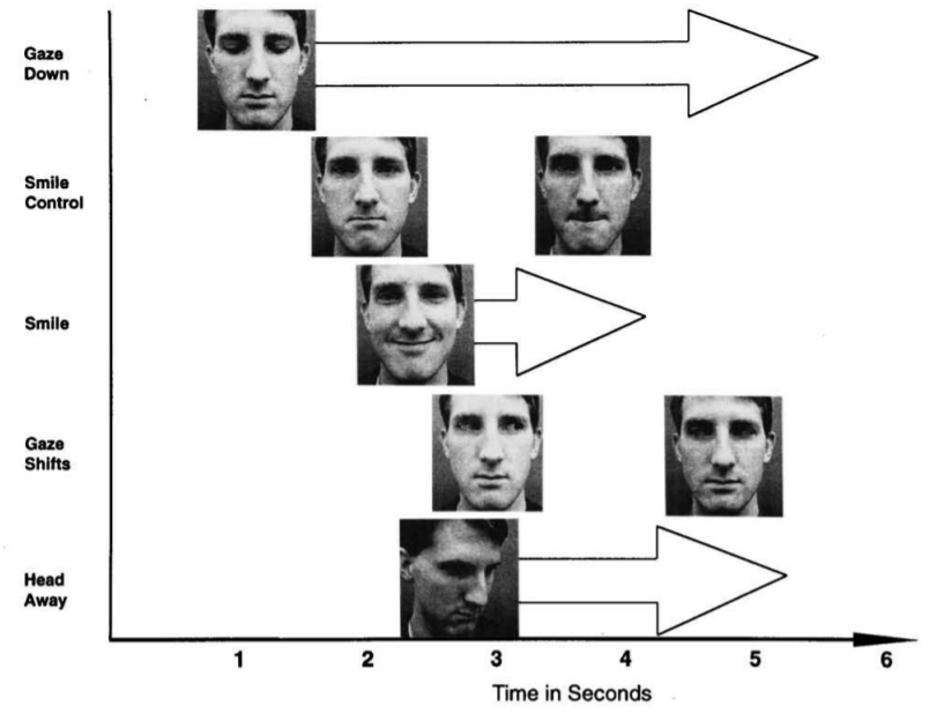
Reproduced from D. Keltner, 1995, Signs of appeasement: Evidence for the distinct displays of embarrassment, amusement, and shame. Journal of Personality and Social Psychology, 68(3),p. 445 (https://doi.org/10.1037/0022-3514.68.3.441) Copyright 1995 by the American Psychological Association.
Some theorists believe the embarrassment facial expression serves an adaptive purpose – to show appeasement to others (Keltner, 1995; Castelfranchi & Poggi, 1990). The appeasement hypothesis states that when an individual violates a social norm, this elicits anger in group members. By displaying the embarrassment facial expression after violating a norm, people acknowledge that they are aware of their violation and exhibit submission to maintain the social order. Yet, Keltner acknowledged the DFA task is one unique situation that elicited embarrassment and that some of the touching displays could be due to the physiological attachments and not really to embarrassment.
In a follow-up study Keltner (1995) had participants watch a videotape and free list the emotion expressed by the individual in the tape. Participants rated the individuals showing embarrassment as sad, followed by nervous. Participants did not specifically state the term embarrassment (this relates to the Widen and Russell (2011) study below).
In another study, Keltner (1995) explored whether shame and embarrassment facial expressions were unique. In this study, participants watched video recordings of 12– to 13-year-old Caucasian and African American males completing an IQ test. Clips of the IQ test showing facial expressions of amusement, enjoyment, anger, disgust, and shame and guilt were identified using Ekman and Friesen’s (1978) FACS. After watching each clip, participants selected an emotion term (amusement, enjoyment, anger, disgust, and shame and guilt) that described the males’ facial expressions.
Findings showed that participants selected embarrassed labels for the embarrassed expressions displayed by the adolescent males and picked the shame label for males expressing shame. Interestingly, participants were more accurate in labeling embarrassment and shame when they were evaluating expressions of African-American boys compared to Caucasian boys.
Figure 2
Proportion of Sample Selecting Emotion Label of Embarrassed and Shameful Adolescent Males
Shameful Adolescent Male: Shame; African American – 82, Shame; Caucasian – 52, Disgust; African American – 5, Disgust; Caucasian – 20.
Adapted from D. Keltner, 1995, Signs of appeasement: Evidence for the distinct displays of embarrassment, amusement, and shame. Journal of Personality and Social Psychology, 68(3),p. 452 (https://doi.org/10.1037/0022-3514.68.3.441) Copyright 1995 by the American Psychological Association.
In Keltner and Buswell (1996; the classic study we discussed above), they sought to identify the facial expressions associated with embarrassment, shame, and guilt. Participants were shown 14 facial expressions for five seconds. For each of the 14 emotional expressions, they viewed 2 photos of the same female poser and 2 photos of the same male poser. After viewing each photo, they were presented with a list of 14 emotion labels and instructed to select the emotion that was the best match for previously viewed facial expression. They had to select the emotion label within 10 seconds. The 14 emotion labels were:
- Amusement
- Anger
- Awe
- (self)-contempt
- Disgust
- Embarrassment
- Fear
- Guilt
- Happiness
- Pain
- Sadness
- Shame
- Surprise
- Sympathy
- No Emotion
Below, are the photos that the researchers believed corresponded to embarrassment, shame, and sadness.
Table
Keltner and Buswell’s (1996) Facial Expressions of Embarrassment, Shame, and Sadness
Adapted from D. Keltner and D.T. Cordaro, 2017, Understanding multimodal emotional expressions: Recent advances in basic emotion theory. The science of facial expression, p. 59-61. Copyright 2017 by Oxford University.
Figure 4 shows the percentage of participants who selected each emotion when the facial expression displayed was embarrassment. For both female and male posers, a majority of participants selected embarrassment (51% when viewing female posers; 56% when viewing male posers). Not shown in the figure, only 7% of the sample judged the embarrassment photos to be shame.
Figure 4
Percentage of participants who selected each emotion for embarrassment expression
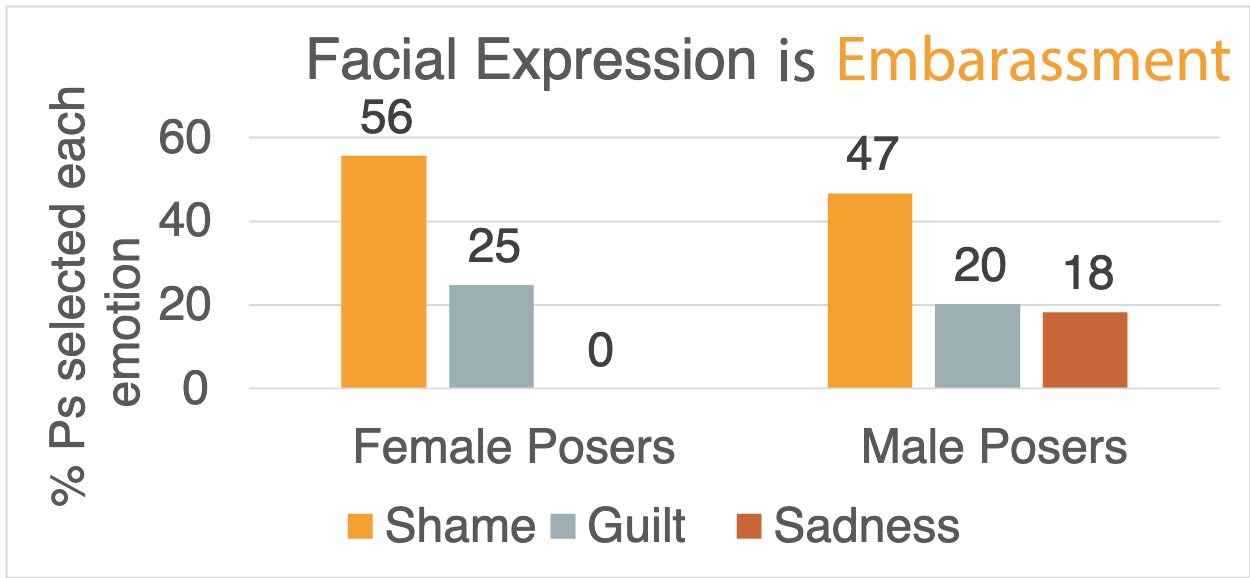
Male Posers: Shame – 47, Guilt – 20, Sadness – 18
Note. Researchers considered 7.2% as above chance; So, when less than 7.2% of sample selected label, label not included in data. Adapted from D., Keltner, & B.N. Buswell, 1996, Evidence for the distinctness of embarrassment, shame, and guilt: A study of recalled antecedents and facial expressions of emotion. Cognition and Emotion, 10(2), p. 166, (https://doi.org/10.1080/026999396380312). Copyright 1996 Psychology Press. Photo reproduced from D. Keltner and D.T. Cordaro, 2017, Understanding multimodal emotional expressions: Recent advances in basic emotion theory. The science of facial expression, p. 59-61. Copyright 2017 by Oxford University.
Figure 5
Percentage of participants who selected each emotion for shame expression
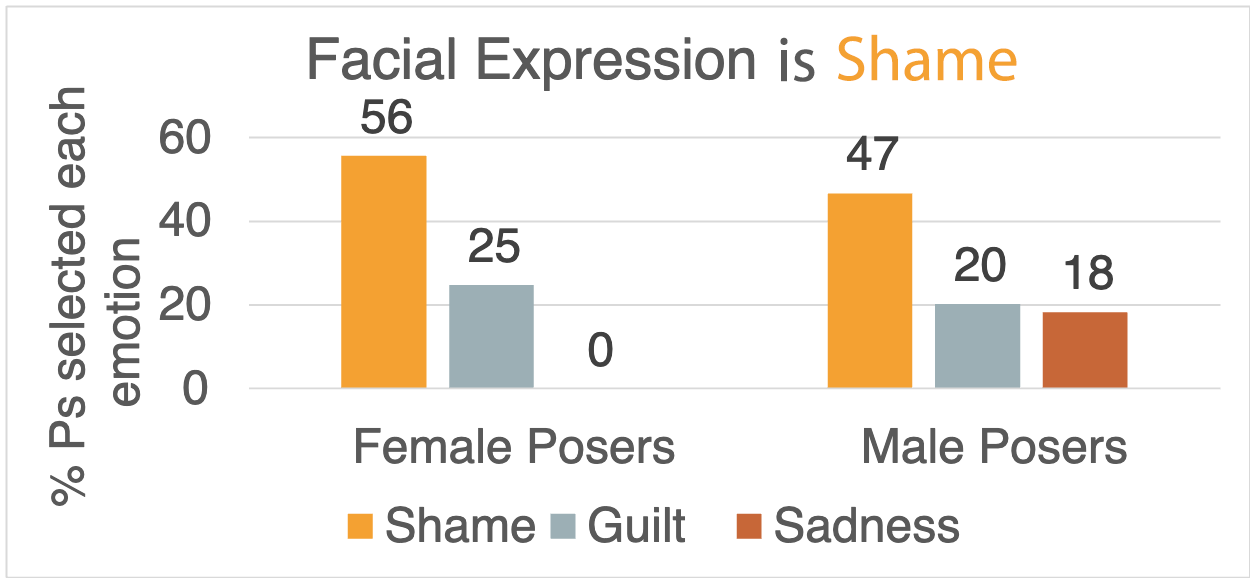
Male Posers: Shame – 47, Guilt – 20, Sadness – 18.
Table 4
Percentage of participants who selected each emotion for basic emotions expression (Keltner & Buswell, 1996
| “Basic” Emotion | Female Posers | Male Posers |
|---|---|---|
| Anger | Anger: 66.7
Disgust: 17.2 Contempt: 11.1 |
Anger: 87.3
Contempt: 07.7 |
| Contempt | Disgust: 66.5
Contempt: 17.5 |
Disgust: 45.6
Contempt: 32.5 |
| Disgust | Disgust: 88.9 | Disgust: 85.9 |
| Fear | Fear: 83.2 | Fear: 91.9 |
| Happiness | Happiness: 89.7 | Happiness: 74.8 |
| Sadness | Sadness: 84.0 | Amusement: 15.6
Sadness: 78.6 |
| Surprise | Surprise: 72.2
Fear: 12.5 Awe: 11.8 |
Surprise: 84.4
Awe: 12.2 |
Note. Researchers considered 7.2% as above chance; So, when less than 7.2% of sample selected label, label not included in data. Adapted from D., Keltner, & B.N. Buswell, 1996, Evidence for the distinctness of embarrassment, shame, and guilt: A study of recalled antecedents and facial expressions of emotion. Cognition and Emotion, 10(2), p. 166, (https://doi.org/10.1080/026999396380312). Copyright 1996 Psychology Press.
Figure 6
Keltner and Buswell’s Facial Expressions Related to Guilt
Adapted from D. Keltner and D.T. Cordaro, 2017, Understanding multimodal emotional expressions: Recent advances in basic emotion theory. The science of facial expression, p. 59-61. Copyright 2017 by Oxford University.
As can be seen in Figure 7, most participants reported self-contempt facial expressions to be shame.
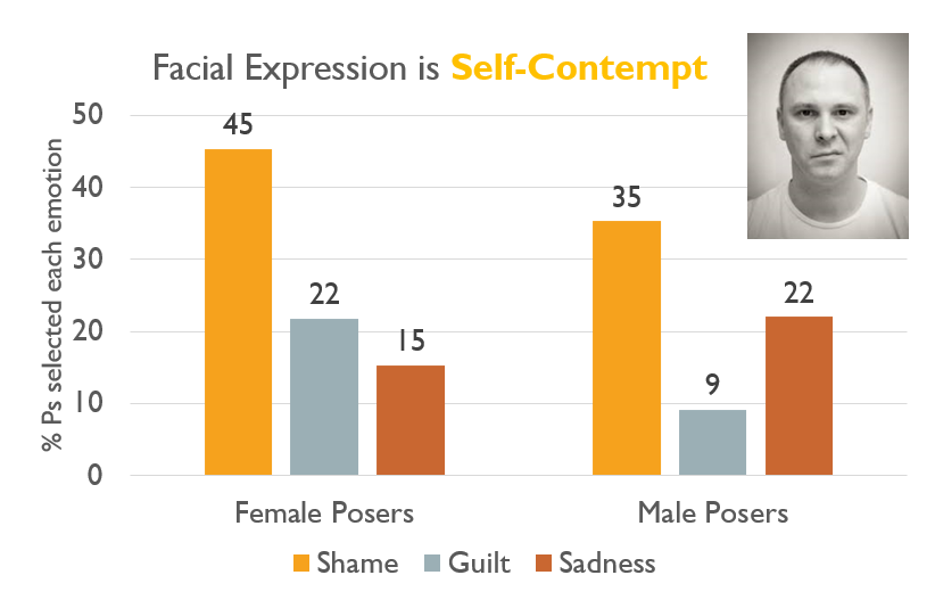
Male Posers: Shame – 35, Guilt – 9, Sadness – 22.
Figure 7
Percentage of participants who selected each emotion for self-contempt expression
Note. Researchers considered 7.2% as above chance; So, when less than 7.2% of sample selected label, label not included in data. Adapted from D., Keltner, & B.N. Buswell, 1996, Evidence for the distinctness of embarrassment, shame, and guilt: A study of recalled antecedents and facial expressions of emotion. Cognition and Emotion, 10(2), p. 166, (https://doi.org/10.1080/026999396380312). Copyright 1996 Psychology Press. Photo reproduced from D. Keltner and D.T. Cordaro, 2017, Understanding multimodal emotional expressions: Recent advances in basic emotion theory. The science of facial expression, p. 59-61. Copyright 2017 by Oxford University.
For the sympathy facial expression (Figure 8), the findings differed according to the gender of the poser. For female posers, 1/3 participants labeled the expression sympathy and another 1/3 selected no emotion. For male posers, 43% selected sympathy, while 36% selected sadness. Guilt was not selected at beyond chance levels.
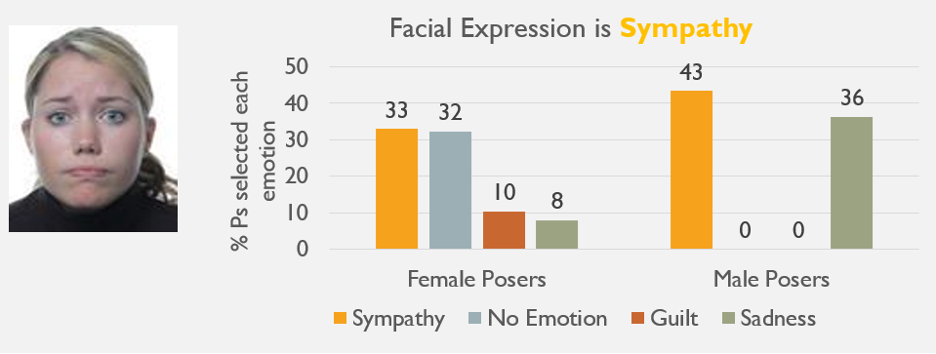
Male Posers: Sympathy – 43, No Emotion – 0, Guilt – 0, Sadness – 36.
Figure 8
Percentage of participants who selected each emotion for sympathy expression
Note. Researchers considered 7.2% as above chance; So, when less than 7.2% of sample selected label, label not included in data. Adapted from D., Keltner, & B.N. Buswell, 1996, Evidence for the distinctness of embarrassment, shame, and guilt: A study of recalled antecedents and facial expressions of emotion. Cognition and Emotion, 10(2), p. 166, (https://doi.org/10.1080/026999396380312). Copyright 1996 Psychology Press. Photo reproduced from D. Keltner and D.T. Cordaro, 2017, Understanding multimodal emotional expressions: Recent advances in basic emotion theory. The science of facial expression, p. 59-61. Copyright 2017 by Oxford University.
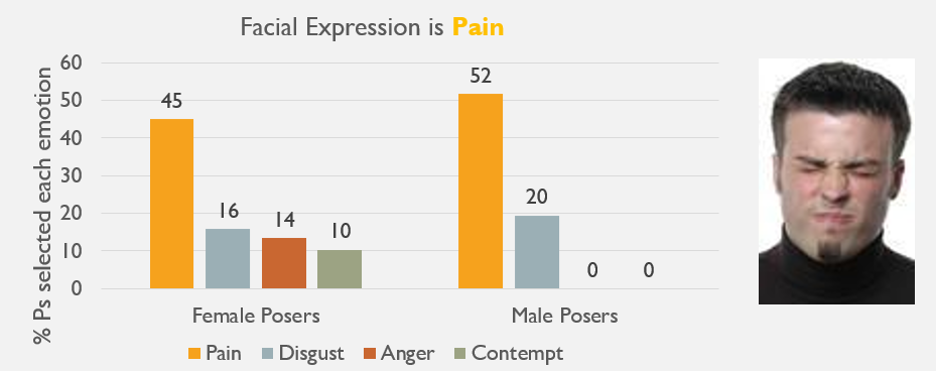
Male Posers: Pain – 52, Disgust – 20, Anger – 0, Contempt – 0.
Figure 9
Percentage of participants who selected each emotion for pain expression
Note. Researchers considered 7.2% as above chance; So, when less than 7.2% of sample selected label, label not included in data. Adapted from D., Keltner, & B.N. Buswell, 1996, Evidence for the distinctness of embarrassment, shame, and guilt: A study of recalled antecedents and facial expressions of emotion. Cognition and Emotion, 10(2), p. 166, (https://doi.org/10.1080/026999396380312). Copyright 1996 Psychology Press. Photo reproduced from D. Keltner and D.T. Cordaro, 2017, Understanding multimodal emotional expressions: Recent advances in basic emotion theory. The science of facial expression, p. 59-61. Copyright 2017 by Oxford University.
Figure 10
Facial Expression Photos from Haidt and Keltner (1999)
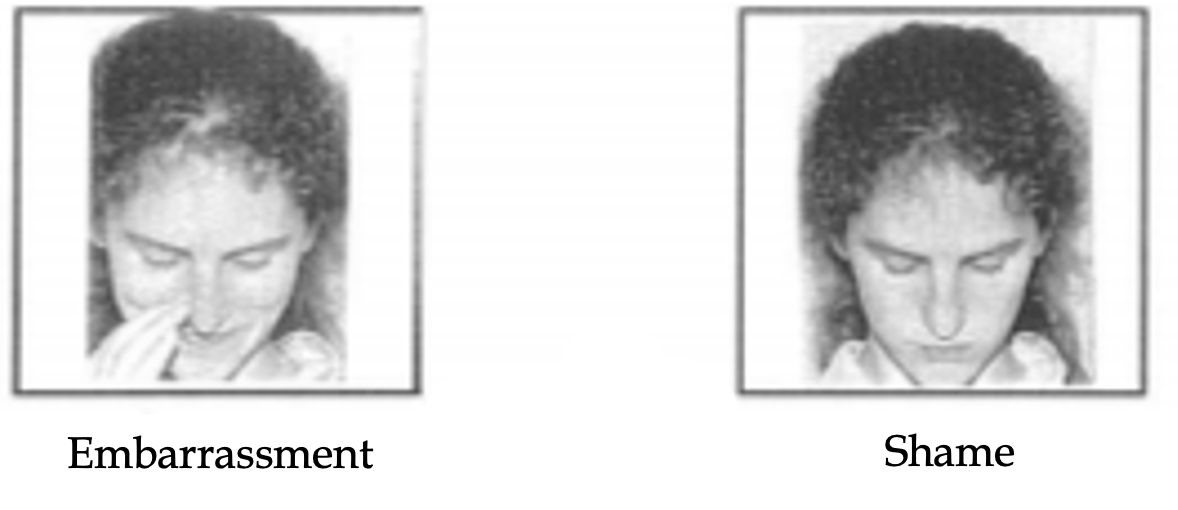
Adapted from J. Haidt and D. Keltner, 1999, Culture and facial expression: Open-ended methods find more expressions and a gradient of recognition. Cognition & Emotion, 13(3), p. 234 (https://doi.org/10.1080/026999399379267) Copyright 1999 Psychology Press.
Figure 11 shows that for the shame and embarrassment facial expressions, participants got more correct when they completed the forced choice method versus the free label method. It is important to note that recognition rates when free labelling the original six basic emotions ranged from . 41 (for disgust) to .94 (for happiness).
Figure 11
Proportion of Correct Forced Choice and Free Labelled Responses for Shame and Embarrassment Facial Expressions
Embarrassment; Forced Choice – 0.48, Embarassment; Free Labelling – 0.31
Adapted from S.C. Widen, A.M. Christy, K. Hewett, and J.A. Russell, 2011, Do proposed facial expressions of contempt, shame, embarrassment, and compassion communicate the predicted emotion?. Cognition & Emotion, 25(5), p. 901. https://doi.org/10.1080/02699931.2010.508270 Copyright 2010 Psychology Press.
Figure 12
Proportion in of Participants Responses for Shame and Guilt Expressions in Free Labeling Session
Embarrassment; Correct – 0.31, Embarrassment; Happy – 0.24, Embarrassment; Sad – 0.23, Embarrassment; Cognition – 0.01
Note. Cognition category includes free labeled responses of “confused, curious, debating, doubtful, perplexed, skeptical, suspicious, uncertain, and unsure” (Widen et al., 2011, p. 900). Adapted from S.C. Widen, A.M. Christy, K. Hewett, and J.A. Russell, 2011, Do proposed facial expressions of contempt, shame, embarrassment, and compassion communicate the predicted emotion?. Cognition & Emotion, 25(5), p.903. https://doi.org/10.1080/02699931.2010.508270 Copyright 2010 Psychology Press.

